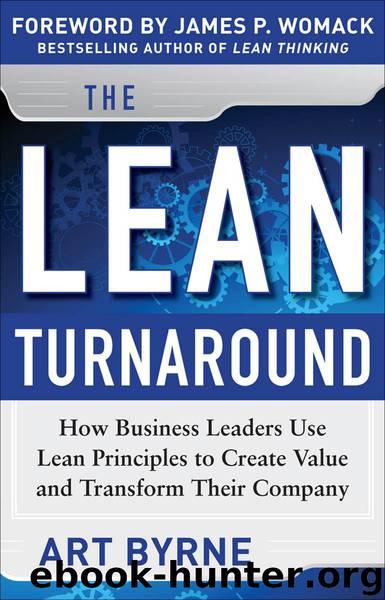The Lean Turnaround: How Business Leaders Use Lean Principles to Create Value and Transform Their Company by James P. Womack & Art Byrne

Author:James P. Womack & Art Byrne [Womack, James P.]
Language: eng
Format: mobi
Publisher: McGraw-Hill
Published: 2012-08-10T14:00:00+00:00
* * *
* * *
Checklist for Creating Pull—Nonmanufacturing Companies
For materials and supplies, follow the manufacturing checklist.
Develop kanban cards for scheduling things like blood labs, MRI equipment, and operating rooms.
For paper processing, set up one-piece flow and let that pull the paper forward.
Use kanban cards to schedule customer visits or to move patients through a hospital until discharge.
* * *
Kanban
Creating a good, robust kanban system is not that easy. To begin with, it is the exact opposite of the MRP and forecasting method that you are probably using now. MRP is a high-inventory model, whereas kanban is a low-inventory model. As kanban are used to link the entire value stream together, it should not be surprising that there are different types of kanban cards for different links. (Customer kanban, conveyance kanban, production kanban, and vendor kanban are a few examples.)
You will need to determine how many kanban cards of each type should be in the system and what quantity of products or parts each kanban should represent. For high-volume products, each kanban card may represent a full pallet of material. For medium-volume products, a kanban card may represent a tote box containing 20 cartons of 10 each. For low-volume products, a kanban card could represent a single carton or even a single box. For custom products in a job-shop environment, you might need a kanban for each product, but you could have kanban for your standard component parts that equaled 10 or 20 parts. For a hospital, a kanban card could represent a patient and could be used to schedule services and track the patient until discharge.
Determining what a kanban quantity is and how many kanban you will need, however, is just the beginning. Next, you will have to teach your people how to handle the kanban cards so that they won’t get lost. This was a big problem for us at Wiremold when we first got the system started. Next, you will have to deal with the demand fluctuations and seasonality of your sales pattern. As the volume of various products increases or decreases, the amount of kanban cards in the system will have to be adjusted. This needs to be done at least once per month.
Once you have sorted all this out, then the customer demand—either through your current system or by sending you a kanban card—initiates all the action. Let’s say that you have six to eight factories, but you ship to customers through a centralized warehouse in order to satisfy their desire to receive different products on a single truck. In this case, the order will come into your system as it does now (perhaps to order entry or inside sales), and once it is entered, it will be printed in the warehouse to be shipped. Simultaneously, as orders come in throughout the day, kanban cards will be printed in the various production cells every time the order quantity reaches the level of one kanban worth of product. Shortly after the kanban card is printed, the cell
Download
This site does not store any files on its server. We only index and link to content provided by other sites. Please contact the content providers to delete copyright contents if any and email us, we'll remove relevant links or contents immediately.
Hit Refresh by Satya Nadella(9011)
The Compound Effect by Darren Hardy(8765)
Change Your Questions, Change Your Life by Marilee Adams(7593)
Nudge - Improving Decisions about Health, Wealth, and Happiness by Thaler Sunstein(7511)
The Black Swan by Nassim Nicholas Taleb(6972)
Deep Work by Cal Newport(6841)
Daring Greatly by Brene Brown(6402)
Rich Dad Poor Dad by Robert T. Kiyosaki(6347)
Principles: Life and Work by Ray Dalio(6163)
Man-made Catastrophes and Risk Information Concealment by Dmitry Chernov & Didier Sornette(5895)
Playing to Win_ How Strategy Really Works by A.G. Lafley & Roger L. Martin(5826)
Digital Minimalism by Cal Newport;(5616)
Big Magic: Creative Living Beyond Fear by Elizabeth Gilbert(5572)
The Myth of the Strong Leader by Archie Brown(5392)
The Slight Edge by Jeff Olson(5331)
Discipline Equals Freedom by Jocko Willink(5252)
The Motivation Myth by Jeff Haden(5137)
Stone's Rules by Roger Stone(5004)
The Laws of Human Nature by Robert Greene(4953)
